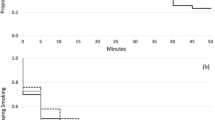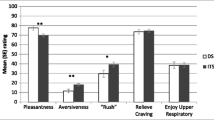Abstract
We evaluated abstinence violation effects (AVEs) (a constellation of negative reactions to a lapse) following an initial lapse to smoking in 105 recent lapsers, and in temptation episodes from these lapsers and from 35 maintainers. Participants used palm-top computers to record AVE data within minutes of the episode, thus avoiding retrospective bias. Lapses resulted in increased negative affect and decreased self-efficacy; participants also felt guilty and discouraged. Lapsers who attributed their lapse to more controllable causes felt worse and more guilty; attributions did not otherwise moderate affective or efficacy reactions. AVE intensity was unrelated to amount smoked, length of abstinence, or performance of immediate or restorative coping. Temptations neither provoked an AVE nor enhanced self-efficacy in either lapsers or maintainers. Maintainers' reactions to temptations were nearly identical to lapsers', except that maintainers felt worse. The data demonstrate the reality of AVE reactions, but do not support hypotheses about their structure or determinants.
Similar content being viewed by others
REFERENCES
Baer, J. S., Kamarck, T., Lichtenstein, E., & Ransom, C. C. (1989). Prediction of smoking relapse: Analysis of temptation and transgressions after initial cessation. Journal of Consulting and Clinical Psychology, 57, 623–627.
Birke, S. A., Edelmann, R. J., & Davis, P. E. (1990). An analysis of the abstinence violation effect in a sample of illicit drug users. British Journal of Addiction, 85, 1299–1307.
Borland, R. (1990). Slip-ups and relapse in attempts to quit smoking. Addictive Behaviors, 15, 235–245.
Brandon, T. H., Tiffany, S., Obremski, K. M., & Baker, T. B. (1990). Postcessation cigarette use: The process of relapse. Addictive Behaviors, 15, 105–114.
Brownell, K., Marlatt, G. A., Lichtenstein, E., & Wilson, G. T. (1986). Understanding and preventing relapse. American Psychologist, 41, 765–782.
Colletti, G., Supnick, J. A., & Rizzo, A. A. (1981, August). An analysis of relapse determinants. Presented at the Annual Meeting of the American Psychological Association, Los Angeles.
Condiotte, M. M., & Lichtenstein, E. (1981). Self-efficacy and relapse in smoking cessation programs. Journal of Consulting and Clinical Psychology, 49, 648–658.
Crowne, D. P., & Marlowe, D. (1960). A new scale of social desirability independent of psychopathology. Journal of Consulting Psychology, 24, 349–354.
Cummings, S. R., & Richard, R. J. (1988). Optimum cutoff points for biochemical validation of smoking status. American Journal of Public Health, 78, 574–575.
Curry, S., & Marlatt, G. A. (1985). Strategies for coping with temptations to smoke. In S. Shiffman & T. A. Wills (Eds.), Coping and substance abuse (pp. 243–265). New York: Academic Press.
Curry, S., Marlatt, G. A., & Gordon, J. R. (1987). Abstinence violation effect: Validation of an attributional construct with smoking cessation. Journal of Consulting and Clinical Psychology, 55, 145–149.
DiClemente, C. C. (1986). Self-efficacy and the addictive behaviors. Special issue: Self-efficacy theory in contemporary psychology. Journal of Social and Clinical Psychology, 4, 302–315.
Garcia, M. E., Schmitz, J. M., & Doerfler, L. A. (1990). A fine-grained analysis of the role of self-efficacy in self-initiated attempts to quit smoking. Journal of Consulting and Clinical Psychology, 58, 317–322.
Gibbons, R. D., Hedeker, D., Elkin, I., Waternaux, C., Kraemer, H. C., Greenhouse, J. B., Shea, T., Imber, S. D., Sotsky, S. M., & Watkins, J. T. (1993). Some conceptual and statistical issues in analysis of longitudinal psychiatric data: Application to the NIMH treatment of depression collaborative research program dataset. Archives of General Psychiatry, 50, 739–750.
Glasgow, R. E., Mullooly, J. P., Vogt, T. M., Stevens, V. J., Lichtenstein, E., Hollis, J. F., Lando, H. A., Severson, H. H., Pearson, K. A., & Vogt, M. R. (1993). Biochemical validation of smoking status: Pros, cons, and data from four low-intensity intervention trials. Addictive Behaviors, 18, 511–527.
Grilo, C. M., & Shiffman, S. (1994). Longitudinal investigation of the abstinence violation effect in binge eaters. Journal of Consulting and Clinical Psychology, 62, 611–619.
Grove, J. R. (1993). Attributional correlates of cessation self-efficacy among smokers. Addictive Behaviors, 18, 311–320.
Hammersley, R. (1994). A digest of memory phenomena for addiction research. Addiction, 89, 283–293.
Hedeker, D., Gibbons, R. D., & Flay, B. R. (1994). Random-effects regression models for clustered data with an example from smoking prevention research. Journal of Consulting and Clinical Psychology, 62, 757–765.
Lichtenstein, E., & Glasgow, R. E. (1992). Smoking cessation: What have we learned over the past decade? Journal of Consulting and Clinical Psychology, 60, 518–527.
Marlatt, G. A., & Gordon, J. R. (1985). Relapse prevention. New York: Guilford Press.
Meddis, R. (1972). Bipolar factors in mood adjective checklists. British Journal of Social and Clinical Psychology, 11, 178–184.
Mermelstein, R., & Lichtenstein, E. (1983, April). Slips vs. relapses in smoking cessation: A situational analysis and coping strategies. Paper presented at the Annual Meeting of the Western Psychological Association, San Francisco.
O'Connell, K. A., & Martin, E. J. (1987). Highly tempting situations associated with abstinence, temporary lapse, and relapse among participants in smoking cessation programs. Journal of Consulting and Clinical Psychology, 55, 367–371.
Ross, M. (1989). Relation of implicit theories to the construction of personal histories. Psychological Review, 96, 341–357.
Schmitz, J. M., Rosenfarb, I. S., & Payne, T. J. (1993). Cognitive and affective responses to successful coping during smoking cessation. Journal of Substance Abuse, 5, 61–72.
Schoeneman, T. J., Hollis, J. F., Stephens, V. J., Fischer, K., & Cheek, P. R. (1988). Recovering stride versus letting it slide: Attributions for “slips” following smoking cessation treatment. Psychology and Health, 2, 335–347.
Shiffman, S. (1982). Relapse following smoking cessation: A situational analysis. Journal of Consulting and Clinical Psychology, 50, 71–86.
Shiffman, S. (1984a). Coping with temptations to smoke. Journal of Consulting and Clinical Psychology, 52, 261–267.
Shiffman, S. (1984b). Cognitive antecedents and sequelae of smoking relapse crises. Journal of Applied Social Psychology, 14, 296–309.
Shiffman, S. (1988). Behavioral assessment. In D. M. Donovan & G. A. Marlatt (Eds.), Assessment of addictive behaviors: Behavioral, cognitive, and physiological procedures (pp. 139–181). New York: Guilford Press.
Shiffman, S. (1992). Relapse process and relapse prevention in addictive behaviors. Behavior Therapist, January, 9–11.
Shiffman, S., Engberg, J., Paty, J. A., Perz, W., Gnys, M., Hickcox, M., & Kassel, J. D. (1997). A day at a time: Predicting smoking relapse from daily urges. Journal of Abnormal Psychology, 106, 104–116.
Shiffman, S., Gnys, M., Paty, J. A., Hickcox, M., Richards, T., & Kassel, J. D. (1996). Temptations to smoke after quitting: Comparison of lapsers and maintainers. Health Psychology, 15, 455–461.
Shiffman, S., Hufford, M., Hickcox, M., Paty, J. A., Gnys, M., Kassel, J. D., & Perz, W. (1997). Remember that? A comparison of real-time vs. retrospective recall of smoking lapses. Journal of Consulting and Clinical Psychology, 65, 292–300.
Shiffman, S., Paty, J. A., Gnys, M., Kassel, J. D., & Hickcox, M. (1996). First lapses to smoking: Within subjects analysis of real time reports. Journal of Consulting and Clinical Psychology, 64, 366–379.
Shiffman, S., Paty, J. A., & Kassel, J. D. (1996). Using palm-top computers for field assessment of behavior. Manuscript submitted for publication.
Stephens, R. S., Curtin, L., Simpson, E. E., & Roffman, R. A. (1994). Testing the abstinence violation effect construct with marijuana cessation. Addictive Behaviors, 19, 23–32.
Stone, A. A., & Shiffman, S. (1994). Ecological momentary assessment (EMA) in behavioral medicine. Annals of Behavioral Medicine, 16, 199–202.
Storms, M. D., & McCaul, K. D. (1976). Attributional processes and emotional exacerbation of dysfunctional behavior. In J. H. Harvey, W. J. Ickes, & R. F. Kidd (Eds.), New directions in attribution research (pp. 143–164). Hillsdale, NJ: Erlbaum.
Weiner, B. (1985). An attributional theory of achievement motivation and emotion. Psychological Review, 92, 548–573.
Wills, T. A., & Shiffman, S. (1985). Coping behavior and its relation to substance use: A conceptual framework. In S. Shiffman & T. A. Wills (Eds.), Coping and substance use (pp. 3–24). New York: Academic Press.
Zeger, S. L., & Liang, K. (1992). An overview of methods for the analysis of longitudinal data. Statistics in Medicine, 11, 1825–1839.
Zeger, S. L., Liang, K., & Albert, P. S. (1988). Models for longitudinal data: A generalized estimating equation approach. Biometrics, 44, 1049–1060.
Author information
Authors and Affiliations
Rights and permissions
About this article
Cite this article
Shiffman, S., Hickcox, M., Paty, J.A. et al. The Abstinence Violation Effect Following Smoking Lapses and Temptations. Cognitive Therapy and Research 21, 497–523 (1997). https://doi.org/10.1023/A:1021853301255
Issue Date:
DOI: https://doi.org/10.1023/A:1021853301255




